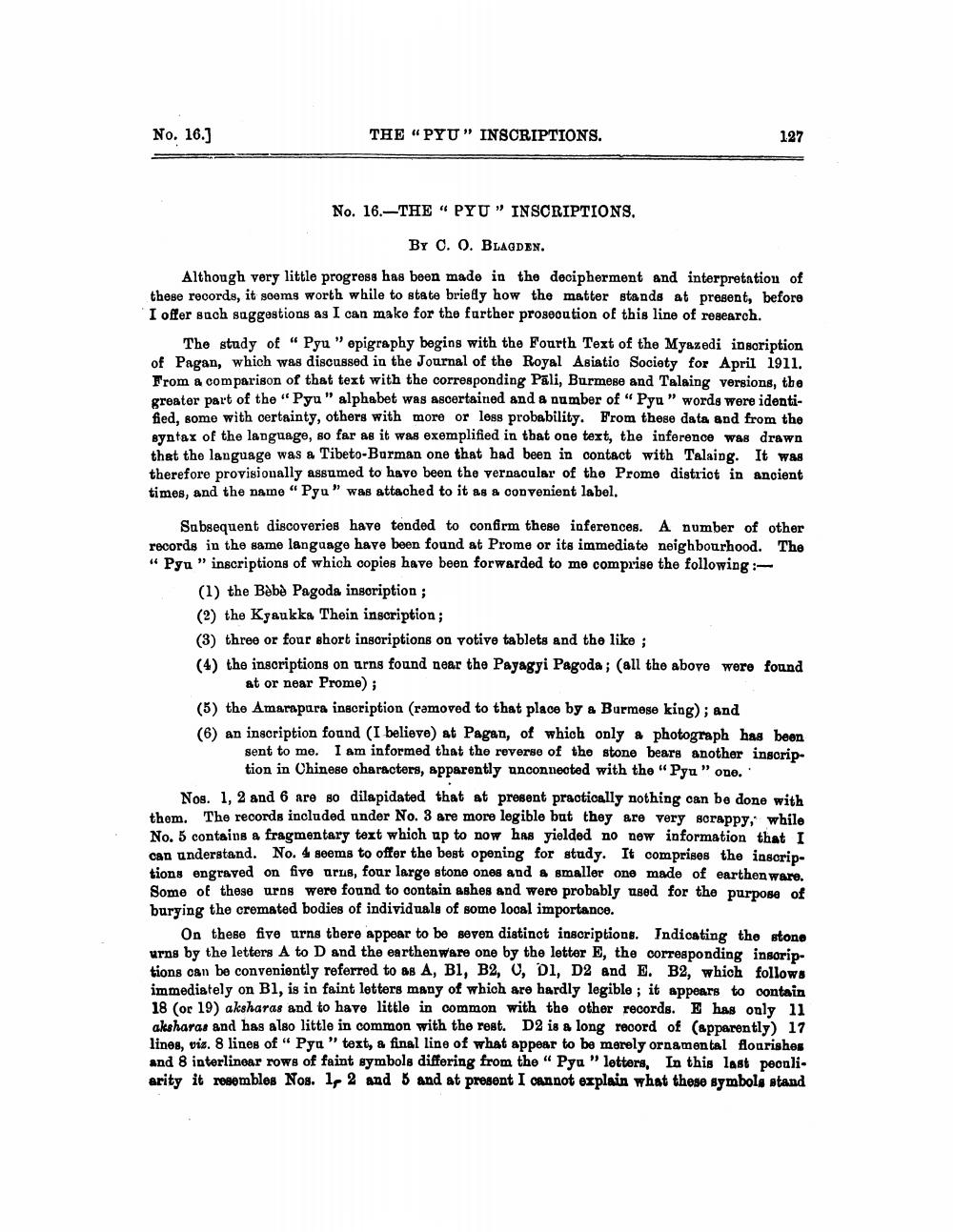________________
No. 16.)
THE “PYU" INSCRIPTIONS.
127
No. 16.-THE "PYU" INSCRIPTIONS
BY C. O. BLAGDEN.
Although very little progress has been made in the decipherment and interpretation of these records, it seems worth while to state briefly how the matter stands at present, before I offer such suggestions as I can make for the farther prosecution of this line of research.
The study of “ Pyu "opigraphy begins with the Fourth Text of the Myazedi inscription of Pagan, which was discussed in the Journal of the Royal Asiatio Society for April 1911. From a comparison of that text with the corresponding Pāli, Burmese and Talaing versions, the greater part of the "Pyu" alphabet was ascertained and a number of "Pyu" words were identified, some with certainty, others with more or less probability. From these data and from the syntax of the language, so far as it was exemplified in that one text, the inference was drawn that the language was a Tibeto-Burman one that had been in contact with Talaing. It was therefore provisionally assumed to have been the vernacular of the Prome district in ancient times, and the name "Pyu" was attached to it as a convenient label.
Subsequent discoveries have tended to confirm these inferences. A number of other records in the same language have been found at Prome or its immediate neighbourhood. The “Pyu ” inscriptions of which copies have been forwarded to me comprise the following :
(1) the Bèbè Pagoda inscription ; (2) the Kyaukka Thein inscription; (3) three or four short inscriptions on votive tablets and the like ; (4) the inscriptions on urns found near the Payagyi Pagoda; (all the above were found
at or near Prome); (5) the Amarapara inscription (ramoved to that place by a Burmese king); and (6) an inscription found (I believe) at Pagan, of which only a photograph has been
sent to me. I am informed that the reverse of the stone bears another inscrip
tion in Chinese characters, apparently unconnected with the "Pya" one. Nos. 1, 2 and 6 are so dilapidated that at present practically nothing can be done with them. The records included under No. 3 are more legible but they are very scrappy, while No. 5 contains a fragmentary text which up to now has yielded no new information that I can understand. No. 4 seems to offer the best opening for study. It comprises the inscriptions engraved on five arus, four large stone ones and a smaller one made of earthen ware. Some of these urns were found to contain ashes and were probably used for the purpose of burying the cremated bodies of individuals of some looal importance.
On these five arns there appear to be seven distinct inscriptions. Indicating the stone urns by the letters A to D and the earthenware one by the letter E, the corresponding insoriptions can be conveniently referred to as A, B1, B2, C, D1, D2 and E. B2, which follows immediately on Bi, is in faint letters many of which are hardly legible; it appears to contain 18 (or 19) aksharas and to have little in common with the other records. E has only 11 aksharas and has also little in common with the rest. D2 is a long record of (apparently) 17 lines, vir. 8 lines of " Pya" text, a final line of what appear to be merely ornamental flourishes and 8 interlinear rows of faint symbols differing from the “ Pyu " letters. In this last peonli. arity it resembles Nos. 1, 2 and 3 and at present I cannot explain what these symbole stand




